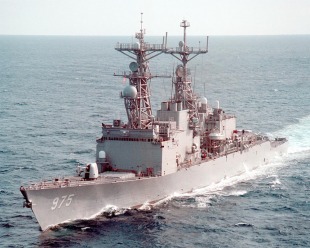Destroyer USS O'Brien (DD-975)
Basic information
Ship measurements
Machine
- 4 * General Electric LM2500 gas turbines
- 2 * shafts, 80,000 shp (60 MW)
Personnel
Combat assets
- AN/SPS-40 air search radar
- AN/SPG-60 fire control radar
- AN/SPS-55 surface search radar
- AN/SPQ-9 gun fire control radar
- Mark 23 TAS automatic detection and tracking radar
- AN/SPS-65 Missile fire control radar
- AN/SQS-53 bow mounted Active sonar
- AN/SQR-19 TACTAS towed array Passive sonar
- Naval Tactical Data System
- AN/SLQ-32 Electronic Warfare System
- AN/SLQ-25 Nixie Torpedo Countermeasures
- Mark 36 SRBOC Decoy Launching System
- AN/SLQ-49 Inflatable Decoys
- 2 * 5 in (127 mm) 54 calibre Mark 45 dual purpose guns
- 2 * 20 mm Phalanx CIWS Mark 15 guns
- 1 * 8 cell ASROC launcher (removed)
- 1 * 8 cell NATO Sea Sparrow Mark 29 missile launcher
- 2 * quadruple Harpoon missile canisters
- 2 * Mark 32 triple 12.75 in (324 mm) torpedo tubes (Mk 46 torpedoes)
- 1 * 61 cell Mk 41 VLS launcher for Tomahawk missiles
- 2 * Sikorsky SH-60 Seahawk LAMPS III helicopters
The USS O'Brien (DD-975) emerged as a Spruance-class destroyer constructed by the Ingalls Shipbuilding Division of Litton Industries in Pascagoula, Mississippi. It honored Captain Jeremiah O'Brien and his five siblings—Gideon, John, William, Dennis, and Joseph. This family served aboard the sloop Unity, capturing HMS Margaretta at Machias harbor's entrance on June 12, 1775. On September 24, 2004, O'Brien was decommissioned, later sunk in a training exercise in 2006.
The destroyer completed seven significant tours to the Western Pacific/Indian Oceans and seven to the Persian Gulf. During the third deployment (January 13, 1984 – August 1, 1984), she rescued refugees twice in the Indian Ocean, earning the Humanitarian Service Medal.
Her fourth Western Pacific deployment (January 1986 – June 1986) extended farther north. Operations encompassed joint U.S./Korean naval exercises TEAM SPIRIT 86 and TAE KWAN DO 86-1, visiting ports including Subic Bay, Manila, Okinawa, Sasebo, Yokosuka, Pohang, Pusan, and Hong Kong.
Following the 1987 installation of an advanced towed array sonar system, O'Brien underwent experimental sonar tests in the Northern Pacific and Bering Sea. In her fifth deployment, she joined the Middle East Force, engaging in Operation Earnest Will and Operation Praying Mantis, pivotal in sinking the Iranian guided missile frigate Sahand.
Subsequent to a comprehensive overhaul in 1988, O'Brien received significant weapon system upgrades, including the Mk 41 Vertical Launch System (VLS) for the Tomahawk cruise missile. She actively participated in Operation Desert Shield in 1990, patrolling the Persian Gulf and inspecting over four hundred vessels as part of the UN embargo on Iraq.
O'Brien's endeavors continued with counter-narcotic operations off Central and South America in December 1991 and February-April 1992, followed by her deployment to Yokosuka, Japan, as a member of the Forward Deployed Naval Forces in August 1992.
During her multiple Middle East Force deployments, O'Brien engaged in operations supporting Operation Southern Watch and United Nations embargoes on Iraq. Notably, in 1996, she participated in RIMPAC '96 and seized over 1.5 million gallons of contraband oil.
Her distinguished service led to various accolades, including the Battle E Device, Meritorious Unit Commendation, and a nomination for the Spokane Trophy.
O'Brien concluded her service in 2006 when she was sunk during a combined fleet training exercise near Kauai, Hawaii, utilizing missiles, shells, and aircraft. The ship's crest symbolized the legacy of courage and perseverance initiated by Jeremiah O'Brien and continued by subsequent ships that bore his name, encompassing elements representing maritime heritage, family lineage, and valor.
- Comments
 en
en ru
ru uk
uk



 United States Navy
United States Navy Ingalls Shipbuilding
Ingalls Shipbuilding